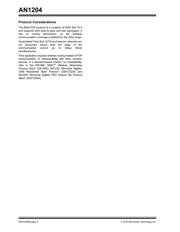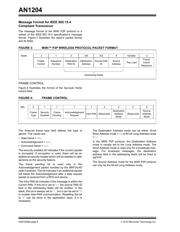下载

© 2010 Microchip Technology Inc. DS01204B-page 1
AN1204
INTRODUCTION
The demand is growing for more and more applications
to move to wireless communication.
The benefits are reduced costs and ease
implementation. Wireless communication does not
require cabling and other hardware, and the associated
installation costs. It also can be implemented in locations
where installing cable is difficult.
Since the IEEE released the Wireless Personal Area
Network (WPAN) specification (IEEE 802.15.4™) in
2003, it has become the real industry standard for low-
rate WPANs (LR-WPAN). The specification applies to
low data rate applications with low-power and low-cost
requirements.
Microchip MiWi™ P2P Wireless Protocol is one of the
wireless protocols that are supported in MiWi
Development Environment (DE). It is a variation of
IEEE 802.15.4, using Microchip’s IEEE 802.15.4
compliant and other proprietary RF transceivers, which
are controlled by Microchip 8, 16 or 32-bit
microcontroller with a Serial Peripheral Interface (SPI).
Microchip MiWi P2P protocol stack is now expanded
beyond IEEE 802.15.4 specification to support
Microchip proprietary transceivers (MRF49XA,
MRF89XA and future proprietary transceivers from
Microchip), while using IEEE 802.15.4 Media Access
Control (MAC) layer design as the reference.
The protocol provides reliable direct wireless
communication through an user friendly programming
interface. It has a rich feature set that can be compiled
in and out of the stack to meet a wide range of
customer needs, while minimizing the stack footprint.
This application note describes the MiWi P2P Protocol
and its differences from IEEE 802.15.4. The document
details the supported features and how to implement
them.
For more information, please refer to the Microchip
application note AN1283 “Microchip Wireless Media
Access Controller - MiMAC’’ (DS01283) and AN1284
‘’Microchip Wireless Application Programming
Interface - MiApp’’ (DS01284).
This application note assumes that readers know C
programming. However, it also recommends that
readers review the IEEE 802.15.4 specification and
Microchip MiMAC/MiApp interfaces before starting this
application note or working with the MiWi P2P wireless
protocol.
Protocol Overview
The MiWi P2P protocol modifies the IEEE 802.15.4
specification’s Media Access Control (MAC) layer by
adding commands that simplify the handshaking
process. It simplifies link disconnection and channel
hopping by providing supplementary MAC commands.
However, application-specific decisions, such as when
to perform an energy detect scan or when to jump
channels, are not defined in the protocol. These issues
are left to the application developer.
Protocol Features
The MiWi P2P Wireless Protocol has the following
features:
• Operates on Microchip PIC18, PIC24, dsPIC33
and PIC32 platforms
• Supports Microchip C18, C30 and C32 compilers
• Functions as a state machine
(not RTOS-dependent)
• Supports a sleeping device at the end of the
communication
• Enables Energy Detect (ED) scanning to operate
on the least-noisy channel
• Provides active scan for detecting existing
connections
• Enables frequency agility (channel hopping)
Author: Yifeng Yang
Microchip Technology Inc.
Microchip MiWi™ P2P Wireless Protocol








